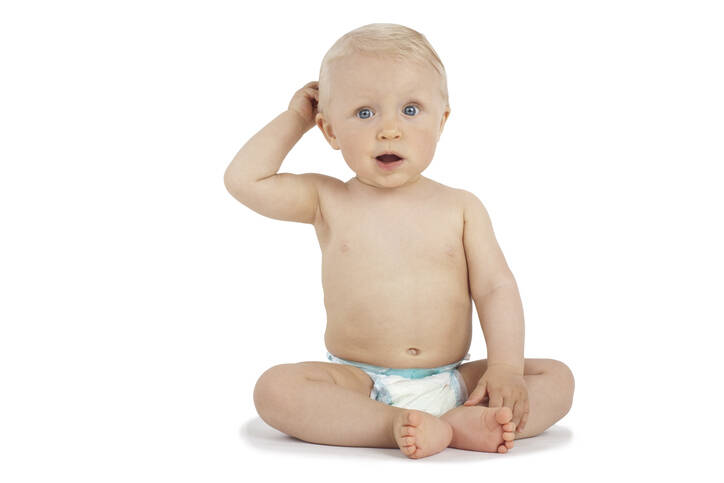What can be the causes of green stools in children?

The stools of babies and older children can tell us a lot about their digestion, but also about their overall health. Green stools are still associated with many myths and half-truths.
Article content
Babies are a source of many surprises from the moment they arrive in the world. Parents get used to a lot of unusual situations when raising their little ones. Even the contents of a baby's nappy can be the source of smiles, but also disturbing feelings.
Green stools may or may not indicate a problem. Let's look together at what all such a coloration of the stool can mean.
Green stools are not hungry stools
This myth has been around for generations. It is often associated with terms like weak milk or hungry milk. Mothers believe that their milk is not nutritious enough. They often stop breastfeeding and replace milk with artificial milk.
However, weak breast milk does not exist.
Breast milk may have less production for various reasons, sometimes changing during the day or the age of the baby. There is also a difference between so-called foremilk and hindmilk. Foremilk is thinner, hindmilk is thicker and has a fat content.
If the mother has enough milk, its quality corresponds to the needs of the baby. It is not weak, it is not lacking in nutrition. The cause of green stools or restlessness of the baby should therefore be sought elsewhere. Not in the insufficient quality of breast milk.
A lot of milk sugar
One of the causes of green-colored stools can be if the baby drinks too much of the so-called foremilk. It can occur in babies who are breastfed. This is the mother's milk that is released from the breast first after attachment.
Because foremilk is thinner, babies may need it quite often, especially in summer when they need to quench their thirst.
Such milk contains a greater amount of milk sugar, which ferments during digestion. In addition to the aforementioned green stools, it can also be accompanied by a greater incidence of wind.
If your baby is suffering from colic (tummy pain associated with frequent winds), try to make sure he drinks enough hind milk as well. Let your baby drink from the breast for longer and do not change breasts after too short a time.
This is not always easy. Especially on hot days, the baby requires more frequent breastfeeding and will drink especially the aforementioned foremilk. A solution could be to offer unsweetened tea or water. However, there is a risk that the baby will easily get used to drinking from a bottle. This may make breastfeeding more difficult.
If you are experiencing such problems, you should contact your paediatrician or see a lactation consultant. She can also help you with many other possible breastfeeding problems.
It is important to observe the baby's general condition. A green colour in the stool is quite common, especially in smaller babies. However, if the baby has an appetite, has no tummy ache, is not vomiting and is gaining weight nicely, there is usually no reason to panic. However, if in any doubt, do not hesitate to contact your paediatrician.
Oxidised stools
The appearance of green stools often does not have to mean anything at all. It can be so-called oxidised stools. These are stools that have been in the nappy for a long time and have changed colour after contact with oxygen.
The baby's stool is perfectly fine. It has just been in the nappy for a long time and may be green in colour.
Hypoallergenic milk
Babies who are not breastfed may experience green stools when given hypoallergenic milk. Such milk may be recommended by your paediatrician based on family history of allergies.
If one of the child's parents is allergic, the doctor may prescribe hypoallergenic milk to prevent the child from developing allergies. A side effect of drinking such milk may be the presence of green stools.
However, this is not a defect. If the baby is happy and has no digestive problems, there is no reason to worry.
However, if in doubt, do not hesitate to consult your paediatrician.
Newborn jaundice
Green stools are also seen in newborns with neonatal jaundice. It occurs mostly on the 2nd or 3rd day after birth and many mothers with a newborn baby have a prolonged hospital stay. It is quite common and affects almost every second newborn.
In this neonatal jaundice, there is a yellow discoloration of the skin and mucous membranes. This happens due to the accumulation of bilirubin. Bilirubin is a bile dye that is released when red blood cells break down.
However, this is a natural phenomenon. These blood cells were present in greater quantities during the time when the fetus was in the mother's body and required greater demands on the oxygen carrying red blood cells.
After birth, the baby breathes on its own and the large number of red blood cells is almost unnecessary. Their breakdown occurs, releasing bilirubin (a yellow dye).
The newborn's liver is not yet developed enough to break down the bilirubin. So the yellow dye is deposited in the skin and mucous membranes. It also leaves traces in the stool. And that's what shows up in the green colour change.
The baby's first stool
The first stool of a newborn is called smolka or meconium. It contains mucus, amniotic fluid, bile and other substances that the baby swallowed during its stay in the womb.
The appearance of this first stool does not look like normal stool, because it is not yet a product of the newborn's diet. Its colour is blackish-green. It gradually turns yellow as the baby takes in milk.
The iron content of the diet
Another cause of green stools, not only in children, can be too high an iron content. A diet rich in iron can partially turn the stool green. This is most often due to too many leafy vegetables or too many iron supplements.
Read also the article.
Diarrhoea
In children and adults, green-coloured stools can also occur if they pass through the digestive system too quickly. In simpler terms, it can occur with diarrhoea.
The green colouration is caused by bile. Bile is light green in colour. During digestion, it changes to yellow to brown due to the action of bacteria. Therefore, if the stool is green, it has not had time to change colour.
There are many causes of diarrhea, from viral or bacterial diseases to parasitic diseases to dietary errors.
Green dye
Whenever there is any unusual stool colouration, try to remember what the child has eaten. Today's market offers a huge variety of tempting and colourful treats for children.
Many contain a large amount of food colouring. This can unusually colour stools. This can be, for example, gelatine, various sweets, popsicles and so on.
Every child is different.
The appearance of stools can vary from one child to another. A breastfed child has different stools from a child on artificial milk. A one-year-old child has different stools from a ten-year-old child.
Read also an interesting article.
If the child is getting fatter and has no other problems, there is usually no reason to worry. However, if you have any doubts, do not hesitate to contact your doctor.
The appearance of the child's stools and the possible cause
| bulky, smelly stools |
|
| thin, foamy stools | |
| Thin, mucousy, green stools, strands of blood |
|
| presence of blood |
|
If the child has a temperature and vomits or feels severe abdominal pain, it is necessary to see a doctor. Read also the article: When and what are the dangers of vomiting in a child
Interesting resources










